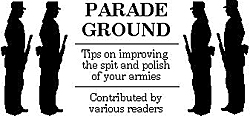 One of my most prized armies is a 15mm World War II American Combat Command. When I first started collecting the miniatures to use for this army, I was disappointed to find that the majority of vehicles were cast with remarkably clean glacis plates and engine decks. I tried to order vehicles identified in catalogs as being "sandbagged" or "detailed," but they never seemed to have the "lived-in" look so prevalent in photographs of American armor in Western Europe. Furthermore, not many of the models that did contain details like tarps, blankets, boxes or tools seemed to have them in the right places. After a lot of trial and error, I hit upon a ridiculously quick and dirty system for converting clean American armor into something looking like what Steven Zaloga calls "a gypsy caravan."
One of my most prized armies is a 15mm World War II American Combat Command. When I first started collecting the miniatures to use for this army, I was disappointed to find that the majority of vehicles were cast with remarkably clean glacis plates and engine decks. I tried to order vehicles identified in catalogs as being "sandbagged" or "detailed," but they never seemed to have the "lived-in" look so prevalent in photographs of American armor in Western Europe. Furthermore, not many of the models that did contain details like tarps, blankets, boxes or tools seemed to have them in the right places. After a lot of trial and error, I hit upon a ridiculously quick and dirty system for converting clean American armor into something looking like what Steven Zaloga calls "a gypsy caravan."
How to Start
First, I paint my vehicles using the black primer-and-drybrush method. I paint the vehicle (for purposes of this article, we'll call it an M4 Sherman), add decals and weathering first. It is far easier to add the baggage to a finished vehicle, and paint only the baggage than try to paint the vehicle and baggage all at once.
After the vehicle is painted, I decide where I want baggage to be placed. I usually add a stack of boxes to the rear engine plate, leaving enough room to allow the turret to turn 270 degrees or so. The height of the stack of boxes usually corresponds roughly to the height of the turret. How do I make the boxes? I use chunks of balsa and hunks of lead sprues, then glue them down to the glacis plate in a slightly irregular pattern (not so much that the stack looks as though it will fall over, but enough that some rough edges stick out). Just glue these pieces on unpainted -- they'll be covered with tarp soon enough. I also take pieces of thin dowel rod and place them in a bundle somewhere along the stack to look like pipe.
Modifying the Model
If I'm interested in placing stowage along the front glacis of an M4, I do what the vets in the tank did: I build a shelf. This runs across the front edge of the tank, and can rest on top of the front tread corner covers, or in between them. Once the shelf is in place, I simply build the stowage as before. Try to make sure you don't cover anything important, such as the driver's port!
After the boxes and such dry, I prepare a tarp to cover the stowage completely (you can also leave some showing, and decide to paint it up later). I take tissue paper (not facial tissue paper; use the kind you receive in Xmas and birthday packages) and cut a square large enough to completely cover the stowage. I then place the square on a spoon, and soak it for 10-15 seconds in a 50/50 solution of warm water and white glue. I then take out the tissue paper and set it on the stowage, using an X-acto knife to work the tarp around so that all parts of the stowage is covered. Use the knife to make sure that the tarp doesn't look "puffy" on top (from trapped air), and settle the tarp down on top so that it catches the angular corners and edges of your boxes and stowage (just the way a real tarp would. Once it is in place, allow it to dry.
Finishing Touches
A few hours later, come back to the vehicle. You now have a nicely-painted vehicle with a yellow-white tarp cover on the front and back. To prepare the tarp for painting, I use Citadel's black wash, and thoroughly paint the tarp black. The tissue paper will soak the wash up, so make sure you apply a couple of coats. Once the wash is dry, I dry-brush a good layer of olive drab on the tarp-covered stowage, then add a little white and repeat the dry-brush to taste.
Old Glory's bags of Soviet tanks frequently come with wood planks, and I sometimes take these and add them to the sides of my Shermans and other tanks in accordance with period photographs. When you are finished, you have a tank with tactical numbers and national identifiers partially obscured by mud, grime and a ton of extraneous stowage -- an American tank indeed!
(Note: There are examples of this technique on display in the showcase at the Soldiery at 4256 North High Street, Columbus, OH.)
Back to The Herald 35 Table of Contents
Back to The Herald List of Issues
Back to MagWeb Master Magazine List
© Copyright 2000 by HMGS-GL.
This article appears in MagWeb (Magazine Web) on the Internet World Wide Web. Other military history articles and gaming articles are available at http://www.magweb.com